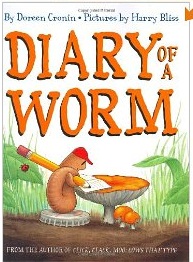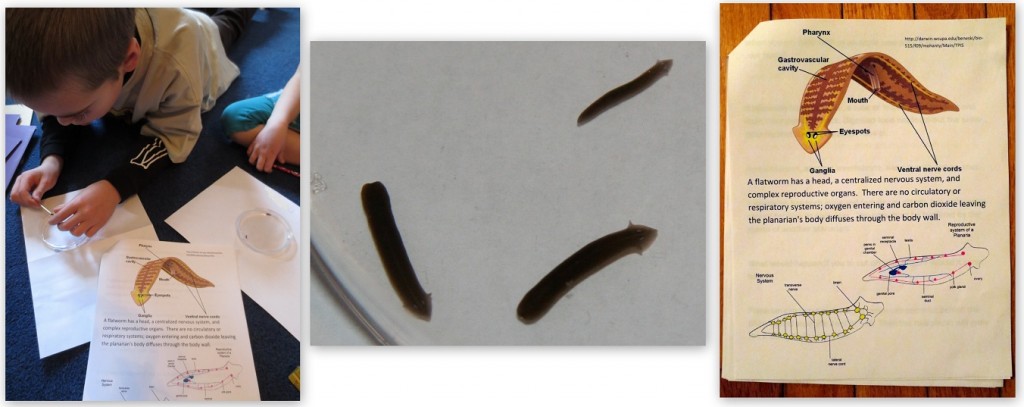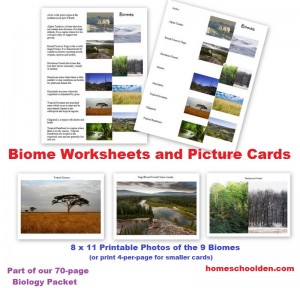Hands-on Invertebrate Fun! (Part 1 – Earthworms)
Once we went over the classification of animals (I shared that post and our Montessori Activities here), we got into the exciting hands-on stuff! We looked at earthworms and a type of flatworm called Planarian. There are some interesting differences in their body systems so we spent time comparing the two.
Our first step was to go out to the garden and find ourselves some earthworms. It was chilly out and we did find some but most of the earthworms were really pretty small. Many were less than a half-inch long! While we were in the garden we noticed we had some broccoli that was ready to pick. Yummy surprise!
We put them in a bin with some soil so we could pull them out and study them over the next few days. We talked about the life cycle of the earthworm, looked and observed the earthworms (some of the earthworms looked practically green), talked about the earthworm’s systems and measured them in both centimeters and inches.
I decided to get an Earthworm Life Cycle Stages Kit (affiliate link) because I really wanted to go into some detail with DD and LD about the reproduction cycle. Earthworms have both male and female reproductive organs, but there needs to be two worms to reproduce because a worm can’t fertilize its own eggs. The earthworms lay next to each other and pass a mucus like substance that allows each worms’ organs to be fertilized. They form eggs in their bodies, form cocoons around the eggs and the cocoons are slid off the worm as they move through the soil. Earthworms eggs take 2 weeks to 3 months to hatch depending on the climate. Each egg cocoon will have 1 or 2 worms in it. When earthworms hatch they lack reproductive organs; these develop after they are hatched. They can use these reproductive organs when they are about 12 months old. Some earthworms can live up to 10 years.
We learned a number of interesting things about earthworms:
- They help break up the soil as they tunnel and provide a path for water to flow.
- They eat other pests.
- They fertilize the soil with their ‘castings.’ (worm poo)
- Earthworms have 5 hearts.
- An adult earthworm can have up to 120-170 segments.
- There are 53,000 earthworms per acre of land.
For their science notebooks, the kids had to draw a picture of the earthworm’s life cycle, observe and draw their own earthworms, see how many segments they could count on their earthworms, and measure them in centimeters and inches.
We had the Diary of a Worm (affiliate link) out on the dining room table all week. The kids picked that up and read it several times during the week. DD said, “I liked it because it was funny and had funny pictures.” I asked DD if it taught her anything about worms. She replied, “Not really, but it is funny!” So there you go!
I’m about out of time and will share part 2 of our hands-on activities– the Planarian with you tomorrow! They are really neat!
You may be interested in these related posts:
- Invertebrate-Vertebrate Unit Study: Montessori Activities:
- Working With Mealworms:
- We also studied Planaria (a type of flatworm): Hands-On Invertebrate Fun! Part II – Planarian – which you can order. They are easy to care for and are fascinating to study because they regenerate.
- Animals and Their Groups
- Animals and their Characteristics
- Animals Around the World – Free Montessori 3-Part Cards
- Animal Portfolio Project (for ages 8-10 or so)
- Free Montessori World Pin Map
Other Preschool related posts you might be interested in:
- Preschool at Home: Activities you can do with your 2-4 Year Olds, Fine Motor Skills
- Preschool at Home: Learning Letters
- Preschool at Home: Alphabet Activities
- Preschool at Home: Handwriting
- Preschool at Home: Science for 2-4 Year Olds
- Preschool Montessori: Vertebrate and Invertebrate Study and Free Cards
- Preschool at Home: A Few Math Ideas for the 2 1/2-3 year old crowd
- Preschool Math Activities (K4) Montessori Math and More
- Preschool at Home: Lapbooks
- You might also be interested in the post: Homeschool Preschool Year in Review which was a recap of many of our preschool activities this past year.
- Preschool Geography: Activities for learning about where we live in the world, Montessori world map work and more
- Preschool Geography: Maps and More
- The Seven Continents and World Landmarks
See you again soon here or over at our Homeschool Den Facebook Page. Don’t forget to Subscribe to our Homeschool Den Newsletter! ~Liesl



























































1 Response
[…] Earthworms, Planarian […]